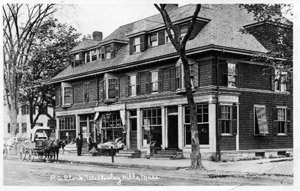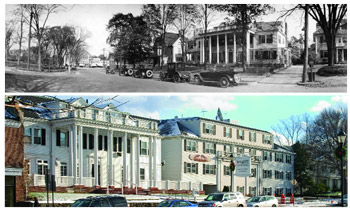Happy Birthday Wellesley
As Wellesley prepares to celebrate its 125th anniversary, we celebrate the past and contemplate the future of our unique town.
Suzanne Hansmire writer
Milestone anniversaries allow us an opportunity to examine past achievements and ponder the future. So as the town of Wellesley prepares for its 125th anniversary this April 6th, it’s an occasion to reflect on how the past has shaped the town’s character.
The story of the origins of the town is melodramatic. According to Five Pounds of Currency, Three Pounds of Corn: Wellesley’s Centennial Story by Elizabeth Hinchliffe, separation of the parishes of West Needham (Wellesley) from East Needham (Needham) was a contentious issue for 70 years leading up to the ultimate split.
In October of 1880, after being thwarted in their desire to separate from Needham for so many decades, the men of Wellesley plotted to arrive an hour early at the town meeting. They packed the seats of the meeting hall at the Town Poor Farm (the building which now houses the Wellesley Country Club).
When the men of Needham arrived there was no more room in the hall. The meeting was loud, chaotic and, by all accounts, even violent, but in the end the Wellesley contingent finally had the votes needed to send a representative to the General Court where the issue of separation would be decided.
Elizabeth Hinchliffe finds the descriptions of the raucous events amusing and intriguing. “I would have loved to have been here for that,” she admits, citing the comments of Reverend Cowan who had recently moved to the town from Tennessee. He reportedly commented “my hand has been going involuntarily to my hip pocket repeatedly.”
The Governor signed the Act of Incorporation of the Town of Wellesley on April 6, 1881. The new town was born.
It’s easy to focus on the differences between the Wellesley of today and of 125 years ago. From a town of 2500 residents, it has grown to more than ten times that size, with a population of 26,613 in the 2000 Federal census.
When it comes to money, the changes are even more dramatic. The Treasurer’s Report of 1881 accounted for receipts of $82,202. By the year 2002, the Town Report’s budget showed estimated expenditures of over $70 million. Expenditure for each of Wellesley’s 331 public school students in 1881 was $22.37. In 2004 enrollment had risen to 4229, and the expenditure per student was $9644.50.
On the other hand, descriptions of the Wellesley of old sound familiar. Joseph Fiske, in an 1884 history of Norfolk County, wrote, “The charm of the Town of Wellesley consists in its refined rural atmosphere, its pleasant homes, its delightful drives and its beautiful landscaped scenery.”
Today those sentiments are echoed by Salvatore DeFazio III, or “Tory” as he is known in town. DeFazio is a third-generation Wellesley resident renowned for his community service. He operates his business, The Windsor Press, in the same Wellesley Hills building where his grandparents once operated a “mom and pop” grocery store. Among many roles, he has served as president of the Wellesley Historical Society and was secretary of the seven-person Centennial committee that planned the yearlong celebration of the town’s one- hundredth birthday.
“The best thing about Wellesley is that we still have a quality town,” DeFazio attests. “People never hesitate to step forward and volunteer.”
He cites the budget cuts last year that threatened the branch libraries and closed the Recycling and Disposal Facility’s “Take and Leave” area. “Somehow it evolves,” he says of the town. “People came forward and found a way for [the area] to reopen.” The branch libraries also survived when the Friends of the Wellesley Free Libraries, a volunteer group, successfully raised money to keep them open.
These examples of community involvement have precedents from the beginning of Wellesley’s history. In 1885, Wellesley moved its town meetings from its Poor Farm to an imposing granite and sandstone Town Hall and Library, donated by Horatio Hollis Hunnewell. The building is a Wellesley landmark, and is listed in the National Register of Historic Places.
 Wellesley has lost some landmarks throughout the years. In 1917, a spectacular four-hour fire destroyed Wellesley College’s College Hall. The magnificent multi-turreted building had been nearly an eighth of a mile long and five stories high around an open atrium courtyard. A year earlier, on December 30, 1916, the town lost the Village Church to fire.
Wellesley has lost some landmarks throughout the years. In 1917, a spectacular four-hour fire destroyed Wellesley College’s College Hall. The magnificent multi-turreted building had been nearly an eighth of a mile long and five stories high around an open atrium courtyard. A year earlier, on December 30, 1916, the town lost the Village Church to fire.
Two dramatic losses loom in the future. The Wellesley Inn has closed its doors and is in the redevelopment process, and the Wellesley Country Club has announced plans to raze the building that formerly served as the Poor Farm where the town was born.
For Linda Buffum, chairman of the Wellesley Historical Commission, it’s not only major losses of landmarks that are sad. She worries about the problem she refers to as “the tear-down issue.”
In the summer of 2005, she compiled a list of over 200 homes that had been demolished in the three previous years. She worries that people are aware of the trend as it affects their own neighborhoods, but don’t see its impact on the town.
The five-member commission is a branch of the town government with an annual budget of only $250. “It’s barely enough to cover copy expenses,” says Buffum.
The group has little power. “The reality of it is that we can’t do anything to stop the inn or the country club,” said Buffum. “When they’re privately owned, you can’t. All you can do is make suggestions.”
An ongoing project for the Commission is placing three Wellesley landmarks on the National Register of Historic Places. The Wellesley Hills Clock Tower, the Hills Branch Library, and the Katharine Lee Bates House on Curve Street are all in the process of being registered. If approved, they will join Eaton-Moulton Mill, Wellesley Farms Railroad Station, Wellesley Town Hall, The Intermediate Building and Elm Bank. There are also three historic districts: The Cochituate Aqueduct Linear District, the Sudbury Aqueduct Linear District, and the Hunnewell Estates Historic District.
In February 2005, as the town approached its 125th anniversary, Hinchliffe, DeFazio, Mary Duffy and Norma O’Reilly decided to meet and try to figure out a strategy to commemorate the year. The four had been some of the most active workers during the town’s centennial year. Duffy and DeFazio served on the commission, O’Reilly was their coordinator, and Hinchliffe was a tireless researcher and writer.
“We tried to get funding, coordinate town groups or get clubs or organizations to take on some planning,” Hinchliffe explained.
Mary Duffy fondly remembers the centennial work: “It was such a wonderful committee. In the three and a half years we worked together, no one ever wanted to leave the committee.”
One major legacy of the efforts that year is Centennial Park. But Duffy remembers that the “Holly Trolley” also had its start during the centennial. “We also started the ‘Picnic in the Park.’ We did it as a sing-along.” She explained that when they decided to print song sheets with the words to all the traditional sing-along favorites, some people worried that all those papers would create a litter problem, so they had volunteers available to pick up after the concert. “Do you know, there wasn’t one sheet of paper left there after that concert?” Her voice still sounds amazed a quarter century later. “They were all the old songs, and people really wanted to take those words home with them.”
The events marking the town’s centennial began the previous spring: 1980 – the year when voters approved Proposition 2 1/2. That’s when selectmen voted to buy a 43-acre plot of land that would become Centennial Park. The history book project was undertaken and published. As part of an oral history project, volunteers taped interviews with elderly residents as they reminisced about the Wellesley of days gone by. A gala celebration was planned for April 5th, a Sunday, and the day before the birthday, with a brunch, an auction, and continuous showings of the multimedia show “Wellesley Yesterday” at the high school.
A 2000-pound birthday cake topped with a three-foot high replica of the Town Hall was commissioned, and plans called for a parade from Wellesley Hills to the high school for cake-cutting ceremonies. It’s the memory of the cake ceremony that invariably draws chuckles from those who were present. The capricious New England weather did not favor Wellesley’s plans. According to Duffy, it wasn’t rain that posed the biggest threat to the cake. “It was the wind!” she says. “We looked and we thought, ‘This cake will be covered by sand and grit by the time we get to the high school.’”
Plans were abruptly changed and the Department of Public Works garage became the new venue. The weather and the unprepossessing site did nothing to dampen the enthusiasm of crowds who thronged the garage for their slice of history.
Monday, April 6 was marked by church bells ringing on the hour all day long, special school programs, and a gala dinner, to name just a few of the festivities. High school students Liz St. Jean and Jane Buchanan presented a centennial flag to the town after their design had won a competition. It was raised on the flagpole near the Village Church, but by the following week it was missing and has never been seen again. (Mary Duffy still expresses the hope that someone will feel remorse and return it.)
Even after the gala weekend, special events continued throughout the year. Among the highlights were a musical review created by the Junior Service League, and a house and garden tour sponsored by the garden clubs. The Chamber of Commerce threw a Centennial Ball and an award was presented to the “Centennial Baby,” the first baby born after April 6th. There was also a road race, a special Wellesley Symphony Orchestra concert, an art show by the Wellesley Society of Artists and the Wellesley Arts and Crafts Guild, a Centennial-themed veterans’ parade and a weekend-long country fair.
A time capsule was created and buried in the old library (it’s now behind a plaque on the north wall on the second floor of the new library building). Special commemorative ceremonies marked the Wellesley-Needham football game as the oldest high school football rivalry in the country.
A quarter century later, the volunteer group was disappointed to learn that no funds were available to plan celebrations. Undaunted, they began lobbying clubs and organizations, trying to enlist others who might be willing to plan some event that can tie into the festivities.
“We’re moving along,” DeFazio claims. An eternal optimist, he believes that the event will gather momentum as residents realize what a great opportunity the special anniversary presents. “We’re trying to make it kind of a home grown celebration,” he states, and then laughs, adding, “That’s because we don’t really have a budget.”
Several groups have begun planning their events, and others are discussing ideas. Organizations that had planned activities will give them a birthday theme such as the “Wellesley Wonderful Weekend” in May, and Babson College’s annual “Multi-Cultural Fair” in November.
The historical society hopes to hold a fundraising event at the country club, said DeFazio, and they also want to restore the oral history project tapes and transcripts.
On April 8th, the historical commission will hold a town-wide historical scavenger hunt for elementary-aged children and their families, and for high school students, an essay contest is already underway.
An anniversary website will also showcase two exciting new projects. One is the re-creation of a photo book that was done fifty years ago for the Town’s 75th anniversary. The book will feature recent photographs alongside the historical ones.
The second project is an interactive map of the town that was created by the Class of 1965. Visitors to the website will be able to click on the map and see images and read about different areas of town. “And after 2006 it will be moved to the Town’s website,” says DeFazio.
As events are added to the schedule, they are posted on the calendar at the official anniversary website, www.wellesley125.com.
© 2006 Elm Bank Media



recent comments